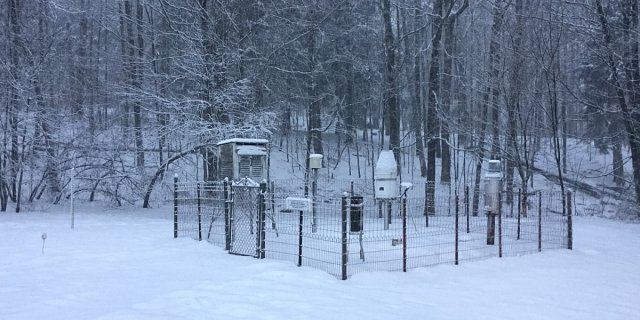Norfolk’s November & December Weather & a Yearly Summary for 2017
By Russell Russ
The surplus of rainfall from October nearly wiped out the yearly deficit that had been slowly growing all year long. The months of November and December were drier than normal, which increased the deficit to close out the year. The year was below normal for total precipitation, but was not even close to our two previous very dry years; 2016 was tied as third driest and 2015 was eighth driest. While 2017 as a whole was warmer than normal, the closing months of the year were a little on the cool side. The conclusion of 2017 completes 86 years of continuous weather observations at the Norfolk 2SW weather station.
November’s average temperature of 36.4 degrees was 0.7 degree below normal. Temperatures ranged from a high of 67 to a low of 14 degrees. Precipitation for the month was just 1.20 inches, 3.39 inches below normal. It was Norfolk’s third driest November on record. The driest Novembers were 2012 with 0.84 and 1976 with 1.04 inches. The monthly snowfall of 1.7 inches was 4.9 inches below normal. The first snowfall of the season came on November 7 (Election Day), when we received 0.9 inch of snow. There were no daily temperature records set in November.
December was even colder. Temperatures ranged from a high of 55 degrees to a low of minus 5. December’s average temperature of 23.0 degrees was 2.7 degrees below normal. This December ranks as Norfolk’s 21st coldest December on record, it tied 1977 and 1983. Below normal for temperature, but not all that impressive. With a total precipitation amount of 2.95 inches, this December was 1.58 inches below normal. December’s monthly snowfall total of 14.7 inches was 2.3 inches below normal. Even with a few days near the end of the month with below zero temperatures, there were no daily temperature records set in December. It has to be really cold to set a low temperature record in late December.
As expected with the colder than normal temperatures, many local ponds started to form ice as early as November 11. The ice went in and out several times in November and early December before finally settling in for the season. Had it not been for a brief warm-up during the first week of December the ice in dates would have been quite early. As it ended up, most of the smaller ponds were iced for the season on December 8 and Tobey Pond and Wangum Lake on December 15. These dates are a few days later than last year, but earlier than most recent years. It was a close one, but a Christmas Eve into Christmas morning snowfall solidified a White Christmas for Norfolk and most of the state.
Norfolk’s weather for 2017 will be remembered as being fairly warm and lacking any major or dramatic weather events. Seven out of twelve months were above normal for temperature and ten out of twelve were below normal for precipitation. Notable months were February for being the second warmest February on record, April for being the fourth warmest April, October for being the third warmest October and November for being the third driest November.
The coldest days of the year did not occur until December 28 and 29 when on both days it was minus 5 degrees. There were only four days in all of 2017 with below zero temperatures, one in January and three in December. There were no days in 2017 that recorded temperatures of 90 degrees or above. The warmest days of the year were May 18 and June 12 with temperatures of 89 degrees. Yes, a little odd that the year’s high temperatures did not even occur during the typical summer months of July and August. The yearly mean temperature was 46.7 degrees, 1.8 degrees above normal. This ranks 2017 as being tied with 1953 as Norfolk’s tenth warmest year on record.
Even with above normal precipitation during two months (May and October) there was a running yearly deficit from January through December. The yearly precipitation amount of 45.83 inches was 6.69 inches below normal, ranking it as Norfolk’s 19th driest year on record.
Snowfall for the 2017 calendar year totaled 68.3 inches, 21.5 inches below normal. February and March were both a little above normal for snowfall, but all other months that typically receive snowfall were below normal. The year of 2017 ranks as Norfolk’s 17th least snowiest year. The 2016-2017 Winter Season (October 2016-May 2017) snowfall total of 88.7 inches was just 1.1 inches below a normal. Had it not been for above average snowfall in November and December 2016 this total would have been considerably lower.


